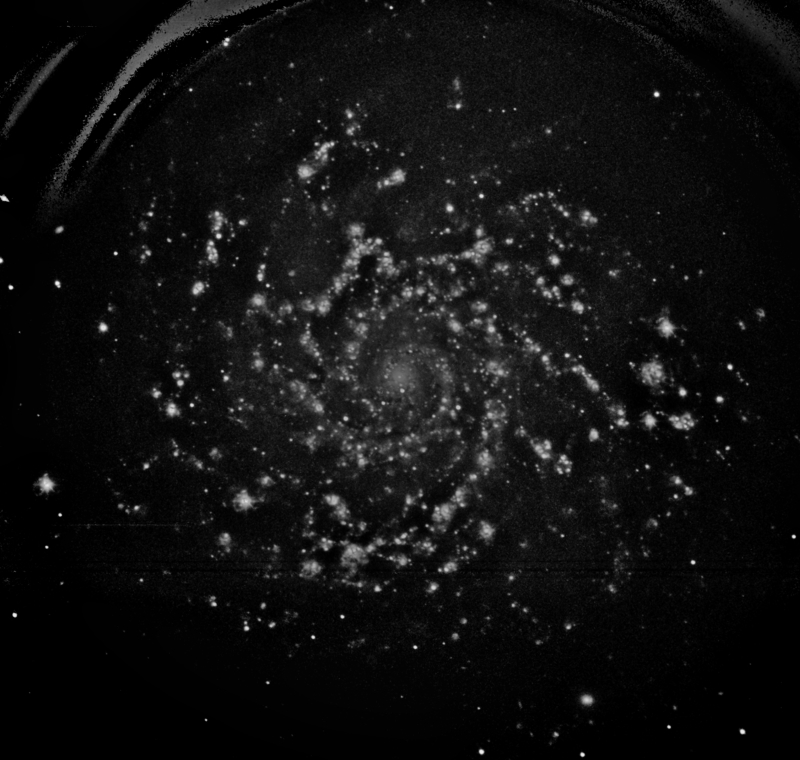Face-on spiral galaxy Messier 74 Versión en español

We present a very deep optical image of galaxy Messier 74, at a distance of some 30 million light-years in Pisces, acquired with the 1.23 metre Zeiss telescope of Calar Alto Observatory. This impressive photograph, belonging to the Documentary Photo Gallery of Calar Alto, reflects all the characteristic traits of great design spiral galaxies.
Messier 74 appears in this image as the perfect archetype of a great design, face-on spiral galaxy, composed by a bright central bulge surrounded by fainter, diffuse spiral arms. Spiral galaxies have flat shapes similar to dishes, what causes a varying appearance depending on their inclination with respect to our line of sight. Therefore, when we look at an edge-on spiral galaxy, the central bulge out stands spheroidal in shape, while the spiral arms apparently display a “line” design. An archetype of edge-on spiral galaxy is NGC 891. An excellent example of spiral galaxy seen under an intermediate angle can be seen in NGC 7331.
The study of all known spiral galaxies has shown that stars at the outer parts of these systems orbit around the centre faster than predicted by physical laws, if we take into account only the mass of stars and gas, just as if there were more matter than deduced “weighting” the luminous objects seen in these island-universes. This unobserved matter, with so clear gravitational effects, is what astronomers called “dark matter”, an exotic and unknown kind of substance that does not emit light, and that constitutes one of the most intriguing challenges for modern astronomy.
Face-on spiral galaxies like M 74 are of high interest to researchers, as they let us look into them in high detail. Such overhead images are of interest to know how the population and behaviour of stars changes along the radial distance from the centre. As this picture clearly shows, the outer parts are bluer than the inner parts, revealing that, on average, the stars near the centre are older than the ones in the spiral arms, full of young stars produced by the still active processes of star formation. It is here, in the spiral arms, where one should expect a higher frequency of some specific types of supernovae, specifically those that mark the catastrophic end for massive, quick-living stars (such stars time ago disappeared in the aged centre of spiral galaxies). Indeed two such supernovae have been found in the spiral arms of this galaxy, in 2002 and 2003, respectively (supernova 2002ap was a peculiar Ib/c explosion, while supernova 2003gd was a type II event). Their light was useful to better calibrate the supernova-based measurement of distances, by comparing their implications with the results yielded by other methods based on classical variable stars.
The Image
The image that we release belongs to the Documentary Photo Gallery of Calar Alto. It has been acquired completely with the Zeiss 1.23 metre telescope of Calar Alto Observatory, used in official time of Descubre Foundation, together with the Documentary School of Astrophotograpy (DSA), in collaboration with the Astronomical Observatory of the University of València (OAUV).
C olour balancing of the image has been done in the same way as in the NGC 7331 image. By taking as white reference the whole light coming from the main galaxy, we can maximize the representation of colour hues in the scene. Such colour representation is not of universal validity, but relative to the specific chromatic content of this scene, but this approach allows distinguishing the different stellar populations inside the galaxy, from the younger and hot bluish stars in the outer regions, to the older and colder reddish ones at the central areas.

Monochromatic version of the image, in the H-alpha band, enhancing the star forming regions in the spiral arms
The image accumulates a total exposure time of 19 hours through Johnson B, V and R filters, as well as in H-alpha emission light. Photographing this galaxy in H-alpha light reveals a rich and complex spiral structure traced by clouds composed by ionised hydrogen, denoting the presence of intense stellar formation activity inside these areas. At the same time, the long integration time, linked to good seeing conditions, reveal aspects seldom displayed in such small portions of the sky. Not only the frame is overflowed by the spiral arms, but we can see in the background the redshifted light of the very distant —in time and space— galaxies that populated the universe several billion years ago.
Download the images
Image credits: Descubre Foundation / Calar Alto / DSA / OAUV,Vicent Peris (OAUV), José Luis Lamadrid (CEFCA), Jack Harvey (SSRO), Steve Mazlin (SSRO), Ivette Rodríguez, Oriol Lehmkuhl, Juan Conejero (PixInsight).
Image of the spiral galaxy M74. Image scale: 0.5”/pixel. The image spans 15 arcminutes on the sky (half the apparent diametre of the full Moon). North is up, East is left.
Monochromatic image in H-alpha band of the spiral galaxy M74. Image scale: 1”/pixel. The galaxy covers some 10 arcminutes on the sky. North is up, East is left.
Astronomy Picture of the Day (APOD) 2011 April 6th
Text: David Galadí-Enríquez


